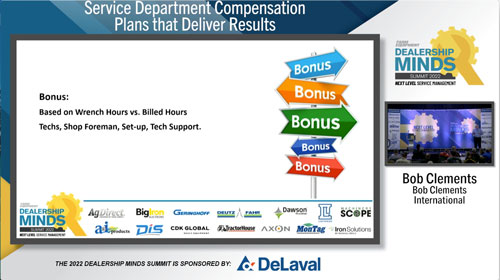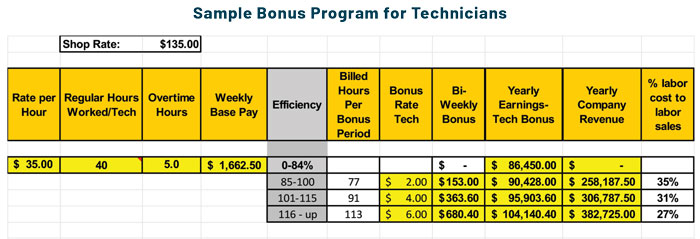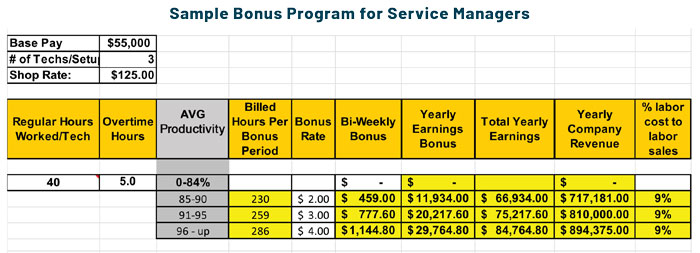In his address to attendees at the 2022 Farm Equipment Dealership Minds Summit, Bob Clements, BCI International, walked dealers through the best practices of the 300-plus dealers he consults with regularly. With all that is at stake in the profitability of the service department, and the ongoing need for talent to turn the wrenches and ring the cash register, compensation programs are of high importance.
Clements maintains that compensation programs must be evaluated annually, as workforces and workforce dynamics shift and change. Compensation is a personal matter and, as he advises, good management requires personal interaction with staff to make sure both parties understand what is desired and what is achievable — through greater performance.
Productivity vs. Efficiency
Productivity: Billed hours ÷ worked hours
Efficiency: Billed hours + gains or losses ÷ revenue hours
“Our goal needs to be to pay employees as much as we possibly can,” he says. Clements believes the best employees should be treated so well — within the scope of the “salary cap” — that they would never want to go anywhere else. And as dealers have learned through these high demand years for the parts and service business, it isn’t hard to calculate the cost associated with unfilled technician openings.
Step 1. Know Your Salary Cap
Clements says dealer-principals often want to jump right to the “dollars and cents” of compensation. But he starts the conversation by asking the owners how much is available to spend on their shop wages. Generally, they don’t know, and he reminds them that one, everything in a dealership has a number, and two, there’s a finite amount of money in the shop to pay wages.
That number, says Clements, is 45% of all labor sales.
That 45% of labor sales is needed to cover the labor cost expenses of the shop, including both the revenue and non-revenue producing work. To determine a dealership’s current “salary cap,” a dealership divides its labor sales expenses for the year by total labor sales. “Most of you will not be close to 45%,” he says, noting most dealers are overpaying the shop at its current performance.
While many dealers use a “gut feel” when it comes to compensation, Clements says that 45% mark is what a dealer can sustainably spend in service operations.
Yet the good news, for dealerships and their shop workers, is that the service department is also ripe for significant — and controllable — efficiency gains.
Compensation’s Singular Purpose: To Follow the Process
What makes service work profitable, says Clements, are good processes. “Compensation programs are designed to do one thing and one thing only — to get people to follow your processes,” he says. “Because the better they follow the processes, the more money they get to make.
“That’s what a compensation program is for. If you don’t have a process in place, then you’re just throwing money away without the results.”
“85% productivity means 15% of your labor time is just ‘walking out,’ like inventory you’ve paid for disappearing…”
The process work comes first, but once in place, a compensation program can be built that reinforces the process. “For instance, if you want salespeople to sell things that you want to get rid of, what do you do? You change the comp program so they make more money on what you need to get rid of.
“Manufacturers do this all the time by spiffing dealer sales teams. The manufacturers want to get rid of certain inventory and understand that if they create a compensation program that’s designed to do it, then they can get that result.
Clements maintains this concept must be understood in service too, but stresses that tight, documented processes are the first step.
A Learning Exercise in Comp Programs
As dealers enlist Clements’ help with compensation programs, the first thing they often say is, “We’ve got to pay our people more.”
Dealers “feel” that way because employees say so (no surprise there), but Clements says many dealers don’t seem to know whether their current plans are working — or not.
Watch the full dealer-to-dealer panel “Service Department Compensation Plans that Deliver Results” from the 2022 Dealership Minds Summit. This and all the Summit session videos are brought to you courtesy of DeLaval.
Clements teaches service managers how to connect with their employees on compensation by first starting a similar conversation with them. Before there’s any talk about how to compensate those reporting to them — whether a service manager, general manager or owner — he asks the manager what he likes most about the way he’s currently compensated.
“If he says, ‘I think how I’m compensated sucks,’ then there’s a problem,” he says. But by asking them how their compensation program could be made better, and what business barriers would need to be worked through to accomplish those changes, there’s an educational component on both sides.
“If you want to make a compensation program that works for employees, ask the employees.”
Conversation with a Technician
Below is a recap of the kind of discussion a good service manager might have with technicians when discussing compensation plans.
Tech: “I’d like to make more money.”
Service Manager: “How much more do you want to make?”
Tech: “I’d like to make as much as I can.”
Service Manager: “Give me a number, tell me what you want to make.”
Tech: “I’d like to make $100,000 a year in my job as a technician.”
Service Manager: “OK what things are stopping you from doing that now?”
Tech: “Because I only get paid so much per hour.”
Service Manager: “So if you got paid more per hour, then that would help you make $100,000?”
Tech: “Absolutely. If you paid me $50-$60 an hour, then I can make $100,000.”
Service Manager: “That’s true. But what barrier would I need to overcome to be able to get that to happen?”
Tech: “I don’t know.”
Service Manager: “What do you know about how the shop works?”
Tech: “I don’t really know.”
Service Manager: “OK, what do we sell in a shop?”
Tech: “Labor.”
Service Manager: “No, we don’t sell labor. That’s a byproduct. What we sell — our product and inventory — is time.”
Tech: “OK, I didn’t know that.”
Service Manager: “That’s why we need you clocking in and out of work orders. Because we’re keeping track of our inventory, our time. We buy time by the hour, we track it by the 10th and we sell it by the half hour.”
Tech: “Right.”
Service Manager: “So if you want to make more money, what we have to do is be better at selling …”
Tech: “Time.”
Service Manager: “Right. And the only way we can be better at selling time is to track it and see where it’s going. Because if we’re losing time, I need to fix that. What do you like most about your compensation program? If you could change or make it better, what would it be? And what sort of barrier would we have to overcome to make that change happen?”
How to Raise Hourly Employees’ Earnings
How to determine how to raise hourly employees — like techs, shop foreman, set-up (PDI), tech support (service coordinators), service writers and warranty writers — is a common question, says Clements.
While starting hourly rates vary widely by geography, the guidelines for how to increase those rates are simple. The hourly rate in a shop should be indexed to your posted labor rate, he says.
So, when a dealer raises its labor rate in the shop 10%, everybody that’s hourly automatically gets a 10% increase in their hourly rate.
With this system, technicians don’t ask you for more money, He says. Instead, they’re trying to get you to increase your shop labor rate. “Because if we can charge more per hour, they automatically get a raise and the more we can charge, the bigger their raise.
“That’s how we pay them. So again, it’s not any mystery; it’s all baked into the formula because what we’re trying to do is work through the salary cap as we go through and do it.”
Bonus Program for a Technician
Bonuses for technicians should be based upon wrench-hours vs. billed hours — how many hours they were turning a wrench and the number of hours that the customer is billed.
So that’s how they get their bonuses, says Clements. Every work order must have a time on it.
“If a technician gets a work order and doesn’t have a time on it, he gives it back to the service manager. Service managers must put a time on that work order. So, all the techs know how much time they must do that job.”
As you will see in the example above, the technician can make considerably more based on three different efficiency levels and is rewarded with the payment every 2 weeks.
Shown is a typical bonus program for a technician with a shop rate of $135 per hour for a tech earning an hourly wage of $35 an hour. He’s working 40 hours with an average of 5 hours of overtime, which puts his weekly base pay at $1,662.50. Clements explains the program below.
The bonus is set up if the tech hits the requirement of 85-100% efficiency over a 2-week average. So, we take all their jobs over 2 weeks, we add them together. If he’s 85-100% efficient, he earns a $2 bonus. Plus, he’s hourly on all those hours. So, if he’s there over a 2-week period and we have 45 hours a week, that would be a total of 90 hours.
If they, in those 90 hours produce 77 hours of billable time, they would be 85%. So, 77 hours billed for $2 is an extra $153 for that 2-week period, plus their normal hourly wage. “If all that technician does all year long is hit that first-level bonus, their annualized earnings would rise from $86,450 to $90,428 (an increase of 4.6%)”.
This performance would represent $258,187 of revenue in the shop, with a cost of 35%. “That’s too high a number as technician labor costs should be no more than 30% of what he’s billing out because there’s also non-revenue producing time, to hopefully be kept under 15%. Again, there’s a total of 45% of labor sales available to pay shop wages.”
But Clements says that if that technician becomes 101-115% efficient, he will have 91 hours billed out of the 90. He now has a $4 bonus per billable hour and the bonus increases to $363.60 for that 2-week period. And at that point, he’d have gone from making $86,450 to $95,903 (a 10.9% increase).
“Most A level technicians are above 116% consistently,” he says. “In this system, they earn a $6 bonus. And if they had that $6 bonus all year long, they’d make an extra $680 per each 2-week period. They’d go from making $86,450 to a $104,140 during that year, a 20.4% increase.”
The impact on cost to labor sales is profound, dropping to 27%. “The more they make, the lower the labor cost. The goal in a shop is to help the technicians reach the maximum level of bonus — all the time.”
The dealer is paying out a lot more bonus, but it produced $382,000 more at a cost of roughly $20,000. That is how a bonus program works, says Clements.
“Employees have the ability at this point to control their own future. So, if somebody says, ‘I want to make $100,000 a year.’ I’d say, ‘Well, you know how we can do that?;” (See “How to Sell More Time” sidebar.)
How to Sell More Time
Once the staff knows that selling more time is the key to its earning power, the next question is how to get there. BCI International’s Bob Clements provides a list of 5 items to help convey the topic to staff.
- Follow the processes.
- Don’t sit in the back, smoke cigarettes and pretend you’re looking for a piece of equipment.
- Always be clocked in on every work order, even if unloading a truck or doing a PDI (both of which are charged to the sales department). “There’s never a time in a shop where somebody is not being billed,” he says. “What you must sell is your time.”
- Once you’re halfway through your allotted time but still not halfway through the job, clock off on the work order, and see the service manager. The service manager is the only person who can give approval to put more time on a job. If a technician stays on a job and overspends his allotted time, there’s 10 or 15 hours on a job that can’t be billed.
- Technicians are bonused on efficiency while managers are incentivized on productivity.
Protective Measures. Clements explains that the system is based on closed work orders as reported out of the dealer management system. And it is based on 2 prior weeks as a protective measure.
Because if there is a comeback or a redo on a tech’s work, he loses 100% of your bonus for that 2-week period.
“That will happen one time in your shop and one time only. From then on, the work will be right when it leaves the shop. I used to own an aviation maintenance company, and I’m a pilot. And I would tell the guys in my aviation shop that we don’t get comebacks in airplanes. Once they’re in the air, people expect them to stay there.
“So don’t rush through the job. If we need more time, you stop, log off the work order, click on your work order and speak to the manager. You go to your manager and tell the manager.”
As an example, Clements talked of a farmer’s son who put Red-Loctite on all the bolts, which were breaking off during a repair. The tech knows that he was given 18 hours to put the clutch in, so he goes to the service manager and says, “I’m going to need about another 3 hours because I’m going to have to drill these out and tap them.”
And then the manager can call the customer, explain what the tech is encountering and say, “We’re going to need about another 3 hours. How do you want us to proceed?’”
Clements maintains that customers understand and want their piece fixed. “What do you think most of the customers going to tell you to do? ‘OK, fine.’
“And now we have approval for more time. Every work order starts with a time, but it doesn’t mean that’s the only time you will get.”
Bonus Program for Service Managers
Service managers and assistant service managers, says Clements, are typically compensated at 85% salary and 15% on productivity bonuses.
Here’s how Clements’ service manager bonus program works for a service manager with a base salary of $55,000 per year. At this dealership, there are 3 techs including setup with a shop labor rate of $125 an hour. Each gets 40 hours plus 5 extra overtime hours
The average productivity in the shop is 85-90%. That would mean there was 230 hours billed out of those 3 technicians. They will get a $2 bonus on each of those hours. And in that 2-week period, the service manager would earn $459 for their bonus plus his $55,000 a year. If unchanged at that level, the yearly total bonus would be $11,934. And they would’ve gone from making 55,000 to $66,934. The labor cost to labor sales is 9%, which is where it needs to be for a service managers, Clements says.
“Let’s say the team is 91-95% productive, it would have 259 hours. The $3 bonus amounts to $777 bonus there, an extra $20,000 a year. And the annual earnings for the service manager went from $55,000 to $75,217. And it’s still at 9% of labor sales. “
Also shown is the impact if a 96% productivity or higher, which is a great number, and is achievable. That will result in $4 bonus and every 2 weeks it’ll add another $1,144. At the end of the year, the service manager is earning $84,000.
“In an ag shop with 3 technicians, I would expect annual service earnings to be $894,000 if things are running right. Three technicians should be producing you nearly $900,000,” Clement says.
Web Exclusives
Visit www.Farm-Equipment.com/1022 for these 3 new pieces from Bob Clements’ 2022 Dealership Minds Summit presentation:
Take Your Service Management to the Next Level
3 Factors Impacting Your Absorption
Winning Comp Plans that Align with Process, Deliver Results
19 Proven Service Processes to Enact Today
Young’s Equipment Measures Hours, Not Dollars
Prioritize Process, Performance & Communication for Service Department Success
Connections with Younger Students Contribute to RDO’s Successful Recruitment Efforts










